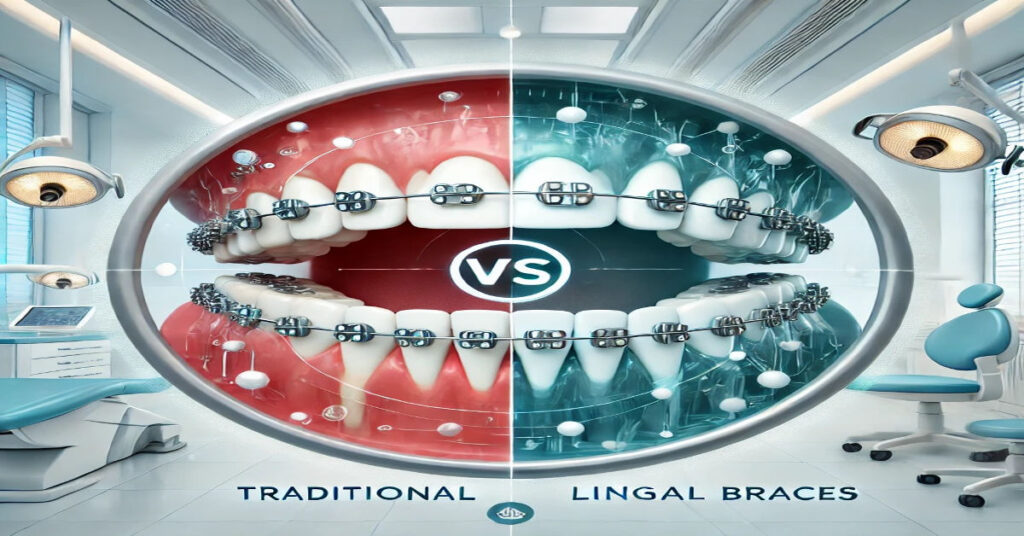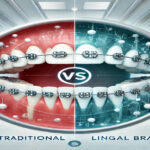When it comes to straightening your teeth the world of orthodontics offers a variety of options. Two popular choices are traditional braces and lingual braces. Both aim to give you a perfect smile, but they differ in terms of visibility, comfort, cost, and maintenance. If you’re torn between the two, this article will break down everything you need to know about braces vs lingual braces helping you make an informed decision.
What Are Traditional Braces?
Traditional braces are the most common orthodontic treatment. They consist of metal brackets attached to the front of your teeth, connected by wires and tiny rubber bands. Over time, the wires are tightened to gradually shift your teeth into the desired position.
Pros of Traditional Braces
- Cost-Effective: Traditional braces are generally more affordable than lingual braces.
- Effective for Complex Cases: They work well for severe misalignments or bite issues.
- Easier Maintenance: Cleaning and adjustments are straightforward.
Cons of Traditional Braces
- Visible Appearance: The metal brackets are noticeable, which can be a concern for some adults.
- Potential Discomfort: The brackets and wires may cause irritation to the cheeks and lips.
What Are Lingual Braces?
Lingual braces are similar to traditional braces but with one key difference—they are placed on the back (lingual side) of your teeth, making them virtually invisible. This makes them a popular choice for adults and teens who want a discreet orthodontic solution.
Pros of Lingual Braces
- Invisibility: Since they are hidden behind your teeth, no one will know you’re wearing braces.
- Custom Fit: Lingual braces are custom-made to fit the contours of your teeth, ensuring comfort.
- Effective Results: They work just as well as traditional braces for most orthodontic issues.
Cons of Lingual Braces
- Higher Cost: Lingual braces are more expensive due to their customization and placement.
- Speech Adjustment: They may temporarily affect your speech, especially during the initial adjustment period.
- Maintenance Challenges: Cleaning can be more difficult since they are placed behind the teeth.
Braces vs Lingual Braces: Key Differences
Visibility
The most obvious difference between the two is visibility. Traditional braces are noticeable, while lingual braces are hidden from view. If discretion is a priority, lingual braces are the clear winner.
Comfort
Traditional braces may cause irritation to the lips and cheeks, but lingual braces can feel bulky on the tongue side. Both options require an adjustment period, but lingual braces might take longer to get used to.
Cost
Traditional braces are more budget-friendly, making them a practical choice for many. Lingual braces, on the other hand, come with a higher price tag due to their custom design and placement.
Maintenance
Cleaning traditional braces is relatively simple, but lingual braces require extra effort since they are harder to reach. Regular dental check-ups are essential for both options to ensure proper care.
Treatment Duration
Both types of braces typically require a similar treatment duration, but this can vary depending on the complexity of your case. Your orthodontist will provide a more accurate timeline during your consultation.
Who Should Choose Traditional Braces?
Traditional braces are ideal for:
- Individuals with severe orthodontic issues.
- Those looking for a cost-effective solution.
- People who don’t mind the visible appearance of braces.
Who Should Choose Lingual Braces?
Lingual braces are perfect for:
- Adults and teens who want a discreet treatment option.
- Individuals with moderate orthodontic issues.
- Those willing to invest in a more customized and invisible solution.
Making the Right Choice
Choosing between braces and lingual braces ultimately depends on your personal preferences, budget, and orthodontic needs. Consulting with an experienced orthodontist is crucial to determine which option aligns best with your goals.
At Art of Smile Philadelphia, we specialize in helping patients navigate these choices. Whether you opt for traditional braces or lingual braces, our team is committed to providing personalized care to help you achieve the smile of your dreams.
Conclusion
Braces vs Lingual Braces offer effective solutions for straightening teeth, but they cater to different needs and preferences. Traditional braces are affordable and reliable, while lingual braces provide a discreet and customized option. By understanding the pros and cons of each, you can make an informed decision that suits your lifestyle and orthodontic requirements.
FAQs
1. Are lingual braces more painful than traditional braces?
Lingual braces may cause initial discomfort due to their placement behind the teeth, but the pain is temporary and similar to traditional braces.
2. Can lingual braces fix severe orthodontic issues?
Yes, lingual braces are effective for most cases, but severe issues may require traditional braces for better results.
3. How long does it take to adjust to lingual braces?
Most people adjust within a few weeks, though speech may take a bit longer to normalize.
4. Are lingual braces harder to clean?
Yes, cleaning lingual braces can be more challenging due to their placement, but proper tools and techniques make it manageable.
5. Which is more expensive: braces or lingual braces?
Lingual braces are generally more expensive due to their custom design and hidden placement.
6. Can I switch from traditional braces to lingual braces mid-treatment?
Switching is possible but depends on your case. Consult your orthodontist to explore this option.







